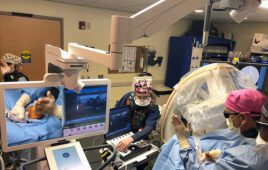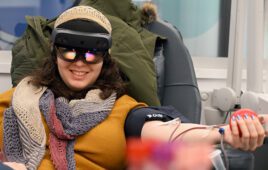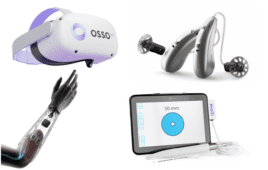
(Image from MediView)
Augmented-reality guidance with electromagnetically tracked tools helped doctors deliver targeted cancer treatments, according to data from one of the technology’s first clinical uses.
The tech by Ohio-based biotechnology startup MediView provides a 3-D holographic view inside a patient’s body, allowing interventional radiologists to accurately burn away tumors while navigating to avoid organs and other critical structures, according to the study released Sunday during a virtual session of the Society of Interventional Radiology’s 2020 annual scientific meeting.
In this initial in-human pilot study, the technology was used to deliver a treatment known as percutaneous thermal ablation of solid liver tumors. Interventional radiologists from the Cleveland Clinic used multi-phase CT to record coordinate markers placed on a patient’s body. This imaging data was added to a software application that allows for segmentation of the tumor and nearby structures within the marked coordinate space. This information was fed into a proprietary AR application, which uses Microsoft’s HoloLens technology, a virtual reality headset with transparent lenses, to project a segmented hologram of the patient’s imaged anatomy directly onto the patient. The hologram is registered to the coordinate markers to ensure accurate location of the relevant anatomy.
Physicians can use electromagnetic tracking to visualize instruments, including the ablation probe, during the procedure, thus allowing for true holographic intraprocedural guidance. Interventional radiologists can then use the combination of the holographic images of the patient’s anatomy and tracked tools to find the tumor in the patient’s liver quickly, check for optimal targeting of the tumor by the ablation probe, and avoid key structures, the study’s authors noted.
The IRB-approved study included five patients who were selected for microwave ablation of their liver tumors. Following ablation, images and video from post-procedural sonography, cone beam and multi-detector row CT and HoloLens recordings were evaluated. In all five cases, intra-procedural holographic guidance was in agreement with the standard ultrasound-based guidance. Post-procedural imaging showed adequate tumor ablation, and no patients experienced tumor recurrence at the three-month follow-up. The technology has only been tested for feasibility and therefore cannot yet be used as a standalone method for delivering a treatment.
The study was funded through internal enterprise grants from Cleveland Clinic and MediView, and can be viewed here.




